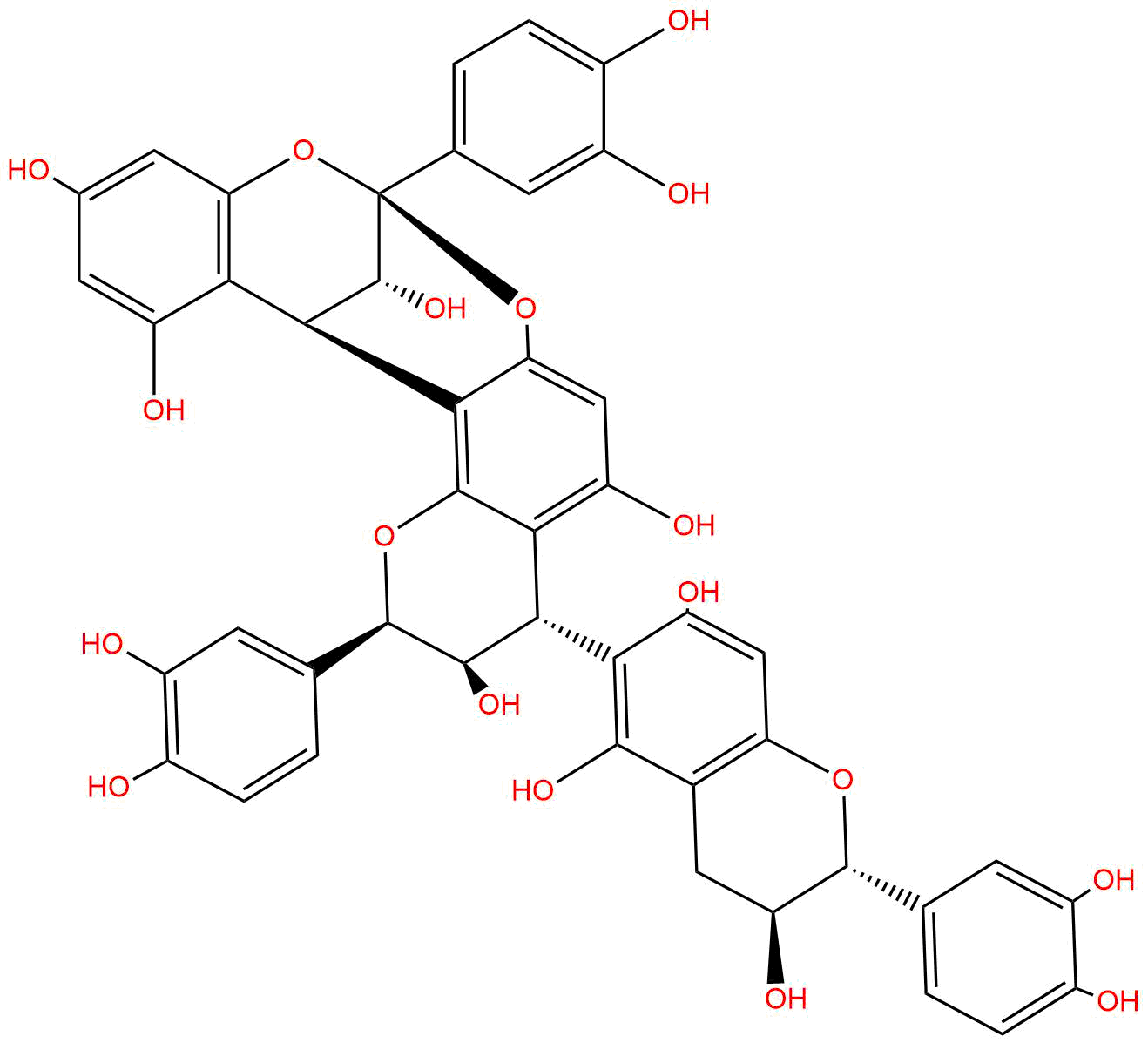Peanut procyanidin CCAS# 2095621-31-9 |

Quality Control & MSDS
Package In Stock
Number of papers citing our products

| Cas No. | 2095621-31-9 | SDF | Download SDF |
| PubChem ID | N/A | Appearance | Powder |
| Formula | C45H36O18 | M.Wt | 864.8 |
| Type of Compound | Procyanidins | Storage | Desiccate at -20°C |
| Solubility | Soluble in Chloroform,Dichloromethane,Ethyl Acetate,DMSO,Acetone,etc. | ||
| General tips | For obtaining a higher solubility , please warm the tube at 37 ℃ and shake it in the ultrasonic bath for a while.Stock solution can be stored below -20℃ for several months. We recommend that you prepare and use the solution on the same day. However, if the test schedule requires, the stock solutions can be prepared in advance, and the stock solution must be sealed and stored below -20℃. In general, the stock solution can be kept for several months. Before use, we recommend that you leave the vial at room temperature for at least an hour before opening it. |
||
| About Packaging | 1. The packaging of the product may be reversed during transportation, cause the high purity compounds to adhere to the neck or cap of the vial.Take the vail out of its packaging and shake gently until the compounds fall to the bottom of the vial. 2. For liquid products, please centrifuge at 500xg to gather the liquid to the bottom of the vial. 3. Try to avoid loss or contamination during the experiment. |
||
| Shipping Condition | Packaging according to customer requirements(5mg, 10mg, 20mg and more). Ship via FedEx, DHL, UPS, EMS or other couriers with RT, or blue ice upon request. | ||

Peanut procyanidin C Dilution Calculator

Peanut procyanidin C Molarity Calculator
| 1 mg | 5 mg | 10 mg | 20 mg | 25 mg | |
| 1 mM | 1.1563 mL | 5.7817 mL | 11.5634 mL | 23.1267 mL | 28.9084 mL |
| 5 mM | 0.2313 mL | 1.1563 mL | 2.3127 mL | 4.6253 mL | 5.7817 mL |
| 10 mM | 0.1156 mL | 0.5782 mL | 1.1563 mL | 2.3127 mL | 2.8908 mL |
| 50 mM | 0.0231 mL | 0.1156 mL | 0.2313 mL | 0.4625 mL | 0.5782 mL |
| 100 mM | 0.0116 mL | 0.0578 mL | 0.1156 mL | 0.2313 mL | 0.2891 mL |
| * Note: If you are in the process of experiment, it's necessary to make the dilution ratios of the samples. The dilution data above is only for reference. Normally, it's can get a better solubility within lower of Concentrations. | |||||

Calcutta University

University of Minnesota

University of Maryland School of Medicine

University of Illinois at Chicago

The Ohio State University

University of Zurich

Harvard University

Colorado State University

Auburn University

Yale University

Worcester Polytechnic Institute

Washington State University

Stanford University

University of Leipzig

Universidade da Beira Interior

The Institute of Cancer Research

Heidelberg University

University of Amsterdam

University of Auckland

TsingHua University

The University of Michigan

Miami University

DRURY University

Jilin University

Fudan University

Wuhan University

Sun Yat-sen University

Universite de Paris

Deemed University

Auckland University

The University of Tokyo

Korea University
- Peanut procyanidin B
Catalog No.:BCN0901
CAS No.:2085301-50-2
- Peanut procyanidin A
Catalog No.:BCN0900
CAS No.:1802175-67-2
- Cinnamtannin B1
Catalog No.:BCN0899
CAS No.:88082-60-4
- Procyanidin C2
Catalog No.:BCN0898
CAS No.:37064-31-6
- Procyanidin B8
Catalog No.:BCN0897
CAS No.:12798-60-6
- Procyanidin B7
Catalog No.:BCN0896
CAS No.:12798-59-3
- Procyanidin B6
Catalog No.:BCN0895
CAS No.:12798-58-2
- Procyanidin A7
Catalog No.:BCN0894
CAS No.:114569-32-3
- Procyanidin A6
Catalog No.:BCN0893
CAS No.:114569-31-2
- Procyanidin A5
Catalog No.:BCN0892
CAS No.:111466-30-9
- Cinnamtannin A3
Catalog No.:BCN0891
CAS No.:86631-39-2
- Delphinidin-3-galactoside chloride
Catalog No.:BCN0890
CAS No.:68852-84-6
- Peanut procyanidin D
Catalog No.:BCN0903
CAS No.:114637-81-9
- Peanut procyanidin E
Catalog No.:BCN0904
CAS No.:2095621-10-4
- Peanut procyanidin F
Catalog No.:BCN0905
CAS No.:2095621-25-1
- Leucocyanidin
Catalog No.:BCN0906
CAS No.:69256-15-1
- Procyanidin B1 3-O-gallate
Catalog No.:BCN0907
CAS No.:79907-45-2
- Procyanidin B2 3-O-gallate
Catalog No.:BCN0908
CAS No.:109280-47-9
- Procyanidin B4 3'-O-gallate
Catalog No.:BCN0909
CAS No.:89064-33-5
- 2-O-Acetylzeylenone
Catalog No.:BCN0910
CAS No.:358748-29-5
- Cinnamtannin A4
Catalog No.:BCN0911
CAS No.:88847-05-6
- Oenothein B
Catalog No.:BCN0912
CAS No.:104987-36-2
- Cinnamtannin B2
Catalog No.:BCN0913
CAS No.:88038-12-4
- Cinnamtannin D1
Catalog No.:BCN0914
CAS No.:97233-06-2
Trimeric and Tetrameric A-Type Procyanidins from Peanut Skins.[Pubmed:28231711]
J Nat Prod. 2017 Feb 24;80(2):415-426.
Peanut skins are a rich source of oligomeric and polymeric procyanidins. The oligomeric fractions are dominated by dimers, trimers, and tetramers. A multistep chromatographic fractionation led to the isolation of four new A-type procyanidins of tri- and tetrameric structures. The structures of the new trimers were defined by NMR, electronic circular dichroism, and MS data as epicatechin-(4beta-->8,2beta-->O-->7)-epicatechin-(4beta-->8,2beta-->O-->7)-catec hin, peanut procyanidin B (3), and epicatechin-(4beta-->8,2beta-->O-->7)-epicatechin-(4beta-->6)-catechin, Peanut procyanidin C (4). The new tetramers were defined as epicatechin-(4beta-->8,2beta-->O-->7)-epicatechin-(4beta-->6)-epicatechin-(4beta- ->8,2beta-->O-->7)-catechin, peanut procyanidin E (1), and epicatechin-(4beta-->8,2beta-->O-->7)-epicatechin-(4beta-->6)-epicatechin-(4beta- ->8,2beta-->O-->7)-epicatechin, peanut procyanidin F (2). In addition, both A-type dimers A1, epicatechin-(4beta-->8,2beta-->O-->7)-catechin, and A2, epicatechin-(4beta-->8,2beta-->O-->7)-epicatechin, as well as two known peanut trimers, ent-epicatechin-(4beta-->6)-epicatechin-(4beta-->8,2beta-->O-->7)-catechin, peanut procyanidin A (5), and epicatechin-(4beta-->8)-epicatechin-(4beta-->8,2beta-->O-->7)-catechin, peanut procyanidin D (6), were also isolated. Dimer A1, the four trimers, and two tetramers were evaluated for anti-inflammatory activity in an in vitro assay, in which LPS-stimulated macrophages were responding with secretion of TNF-alpha, a pro-inflammatory cytokine. Tetramer F (2) was the most potent, suppressing TNF-alpha secretion to 82% at 8.7 muM (10 mug/mL), while tetramer E (1) at the same concentrations caused a 4% suppression. The results of the TNF-alpha secretion inhibition indicate that small structural differences, as in peanut procyanidin tetramers E and F, can be strongly differentiated in biological systems.


